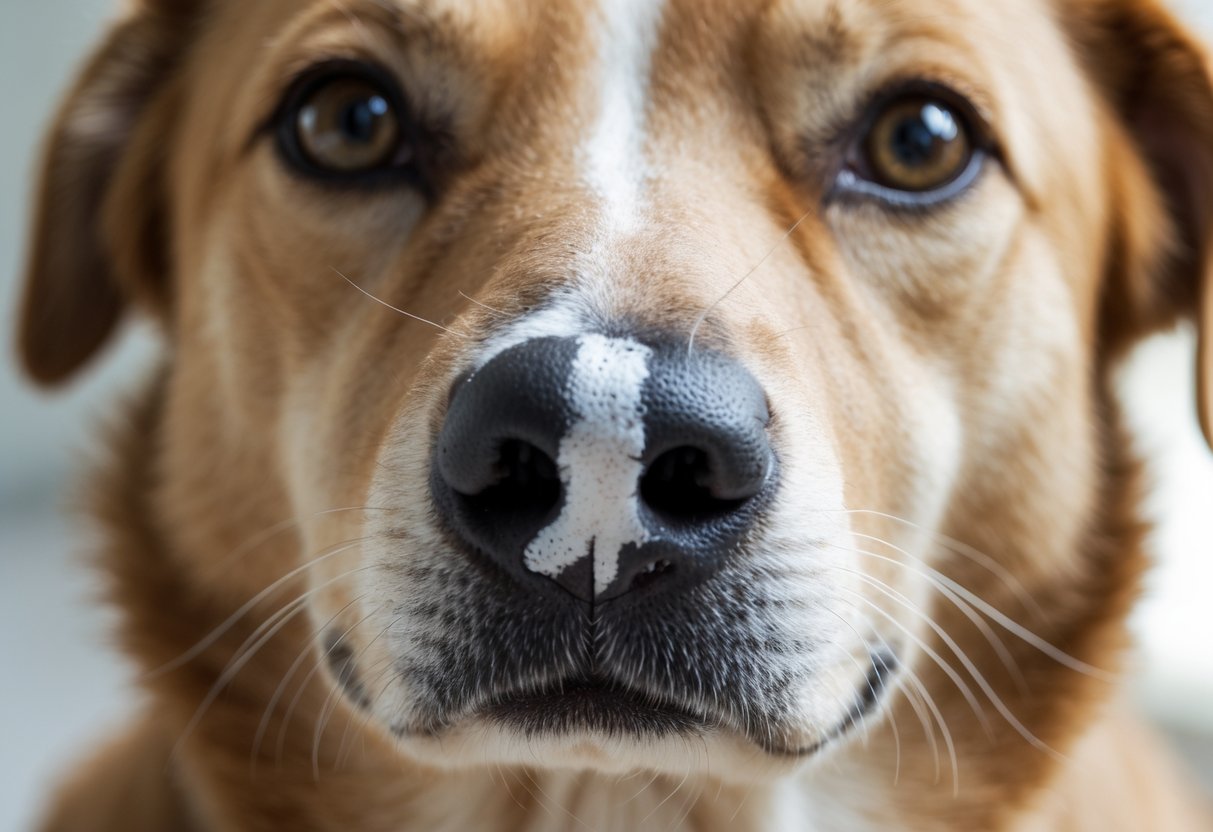White Salt Line on Dog’s Nose: Possible Causes and Care

A white salt line on a dog’s nose can happen for several reasons, some are harmless while others may need attention. Common causes include natural changes like aging, sun exposure, or conditions such as vitiligo and nasal hyperkeratosis.
White salt lines can also signal health issues like autoimmune diseases, infections, or damage from the environment, so it’s important to watch for other symptoms. Understanding the cause helps determine if a vet visit is necessary or if simple care will do.
Dogs’ noses can change color or texture for many reasons, and recognizing these changes early helps keep pets healthy. This article explores the common causes of white salt lines on dogs’ noses and tips for what owners should do next.
Understanding the White Salt Line on a Dog’s Nose

The white salt line on a dog’s nose appears as a light-colored stripe or patch. It may result from several causes, ranging from harmless color changes to signs of health issues. Recognizing what this line is and when it needs attention is important for proper care.
What Is a White Salt Line?
A white salt line is a visible, often horizontal, lighter-colored mark across a dog’s nose. It is not always a part of the dog’s natural pigmentation. Sometimes, the line forms due to loss of pigment, which can happen for many reasons.
These changes might come from seasonal effects like snow nose, where cold weather causes temporary lightening. Another cause is vitiligo, a condition where pigment cells die or stop working. Some dogs might have a white salt line from scarring or skin dryness. It can appear on any breed but is more common in dogs with dark noses.
When to Be Concerned
Most white salt lines are harmless and serve only as a cosmetic change. However, some cases require a veterinary checkup.
Watch for warning signs like:
- Redness or swelling around the nose
- Cracks, bleeding, or oozing
- Unusual behavior such as frequent scratching or pawing at the nose
These signs could indicate infections, allergies, or autoimmune conditions such as discoid lupus erythematosus (DLE) or pemphigus foliaceus (PF). If the white salt line appears suddenly or comes with discomfort, a vet’s evaluation is necessary.
Common Symptoms Accompanying White Salt Lines
White salt lines themselves usually don’t cause symptoms. But they might come with other visible problems, which are important to notice.
Common symptoms include:
- Dry, flaky, or crusty skin
- Whitening or thickening of the nose skin (nasal hyperkeratosis)
- Redness or irritation near the nose
- Changes in nose texture or bleeding
If a dog shows breathing difficulties or signs of pain, owners should seek veterinary advice immediately. These symptoms may be linked to infections or immune diseases that need medical treatment.
Primary Causes of White Salt Line Formation

White salt lines on a dog’s nose can result from specific medical conditions or natural changes in pigmentation. Understanding the main causes helps in identifying which cases require attention and which are harmless.
Snow Nose and Seasonal Pigment Changes
Snow nose causes a loss of pigment on the nose, usually showing as white or faded patches. It often appears when the weather turns colder. This is most common in breeds like Golden Retrievers, Labrador Retrievers, Bernese Mountain Dogs, and Siberian Huskies.
The condition is linked to reduced sun exposure during winter months. The white patches typically start near the middle of the nose and may spread across the surface. Snow nose does not cause pain or affect the dog’s ability to smell. The discoloration often fades as warmer weather returns, but in some cases, it can become permanent.
Nasal Hyperkeratosis
Nasal hyperkeratosis occurs when the skin on the nose produces too much keratin, the protein that protects the skin. This causes thick, dry, and sometimes white or crusty patches on the nose.
The excess keratin buildup creates a rough texture and may form visible white cracks or flakes along the nose. While this condition is usually not painful, it can cause discomfort or irritation for the dog. It tends to be a chronic issue requiring ongoing care. Moisturizing balms or treatments prescribed by a veterinarian help manage it.
Discoid Lupus Erythematosus
Discoid Lupus Erythematosus (DLE) is a chronic autoimmune disease that affects the nose and face. It causes white patches alongside redness, swelling, and possible sores or lesions.
DLE damages the pigment cells, leading to loss of color in affected areas. This type of lupus can last for years and often needs veterinary diagnosis and treatment. Left untreated, it may worsen and cause more severe skin damage. Early vet intervention can reduce symptoms using creams or medications.
Pemphigus Foliaceus
Pemphigus foliaceus is a rare autoimmune skin disease. It causes white crusty or scaly patches on the nose with a white salt-like appearance. Dogs may develop sores where their immune system attacks their own skin.
This condition often appears in middle-aged dogs and may be linked to genetic factors. Breeds like Akitas show higher vulnerability. Pemphigus foliaceus requires veterinary care. Steroid treatments and immune-suppressing drugs are common to control symptoms and prevent further damage. Without treatment, the condition can become severe.
Other Contributing Factors

Several factors beyond illness or infection can cause a white salt line on a dog’s nose. These include environmental conditions, minor injuries, allergies, and natural changes related to age or breed. Understanding these factors helps identify when a white line is harmless or when it might need attention.
Kennel Nose and Physical Irritation
Kennel nose refers to dry, cracked, or flaky skin on a dog’s nose, often caused by repeated exposure to hard surfaces, licking, or environmental dryness. This condition can create a white, salt-like line or patch on the nose due to skin peeling or buildup of dead skin cells.
Physical irritation occurs when dogs rub their nose on rough surfaces or scratch due to itchiness. This can result in white lines or spots that resemble salt streaks.
Kennel nose is usually not serious but can cause discomfort, especially if the nose cracks deeply. Moisturizing the nose with vet-approved balms and minimizing rough contact can help reduce symptoms.
Allergic Reactions
Dogs can develop white lines on their noses from allergic reactions. These allergies may come from food, pollen, dust, or chemicals like cleaning products.
Allergic reactions often cause redness, swelling, and itching along with the white line. The white color might appear from dryness or mild skin damage due to persistent scratching or rubbing.
It is important to observe the dog for other allergy signs, such as watery eyes or sneezing. If allergies are suspected, a vet can help identify triggers and suggest treatment options like antihistamines or special diets.
Aging and Genetic Factors
A dog’s nose color can change naturally with age. Some dogs develop white or lighter lines or spots on their nose as they get older. This is similar to how humans get gray hair with age.
Certain breeds may be more prone to these changes due to genetics. Vitiligo, a condition causing loss of pigment, can create white lines or patches and often runs in families.
Age-related changes and genetic causes are usually harmless. However, if the white line appears suddenly or changes in form, a vet should check for underlying health issues.
Diagnosis, Treatment, and Pet Owner Considerations

When a white salt line appears on a dog’s nose, it is important to assess the cause accurately and choose the right treatment. Understanding the proper steps for diagnosis and available care options helps pet owners respond effectively. Insurance can also play a role in managing costs related to diagnosis and treatment.
Veterinary Diagnosis and Home Assessment
A veterinarian will examine the dog’s nose and overall health to find the cause of the white salt line. They may ask about changes in behavior, exposure to sun, or presence of other symptoms like itching or discharge. In some cases, skin scraping or blood tests are needed to rule out infections or autoimmune diseases such as vitiligo or discoid lupus.
At home, owners should monitor the dog for any swelling, pain, or worsening of the white line. Taking photos and noting when the change appeared can help the vet. Avoid using any creams or medications without professional advice as this might worsen the issue.
Available Treatment Options
Treatment depends on the underlying cause of the white salt line. For harmless reasons like snow nose or mild sun damage, simply protecting the nose from UV light using pet-safe balms may help. In cases of infections or autoimmune diseases, vets often prescribe antibiotics, antifungals, or steroids.
For chronic conditions like nasal hyperkeratosis, moisturizing balms can reduce dryness and cracking. It’s important that treatment follows a vet’s guidance to avoid side effects or delays in healing. Some dogs may need ongoing care if the condition is related to aging or genetics.
Role of Pet Insurance
Pet insurance can help cover veterinary visits, diagnostic tests, and treatments associated with nasal conditions. Many policies include coverage for skin disorders and autoimmune diseases, but owners should check their plans carefully.
Insurance may reduce out-of-pocket expenses, especially if long-term care or specialist visits are required. Early diagnosis and treatment save money and improve outcomes, making insurance a helpful option for managing unexpected health issues like a white salt line on the nose.

Frequently Asked Questions
A white salt line on a dog’s nose can be linked to various health issues, skin conditions, and environmental factors. Some causes require medical attention, while others can be managed or treated at home with care.
